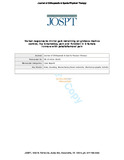Varied response to mirror gait retraining of gluteus medius control, hip kinematics, pain, and function in 2 female runners with patellofemoral pain.
Author
Willy, Richard W.; Davis, Irene S.
Abstract
STUDY DESIGN:
Case report.
BACKGROUND:
The underlying mechanism of the changes in running mechanics after gait retraining is presently unknown. This case report assesses changes in muscle coordination and kinematics during treadmill running and step ascent in 2 female runners with patellofemoral pain after mirror gait retraining.
CASE DESCRIPTION:
Two female runners with chronic patellofemoral pain underwent 8 sessions of mirror gait retraining during treadmill running. Subjective measures and hip abductor strength were recorded at baseline and after the retraining phase. Changes in hip mechanics and electromyography data of the gluteus medius during treadmill running and step ascent were also assessed.
OUTCOMES:
Both runners reported improvements in pain and function that were maintained for at least 3 months. During running, peak contralateral pelvic drop (baseline-postretraining difference: runner 1, 2.6° less; runner 2, 1.7° less) and peak hip adduction (baseline-postretraining difference: runner 1, 5.2° less; runner 2, 6.3° less) were reduced after retraining. Kinematic reductions accompanied earlier activation of the gluteus medius relative to foot strike (baseline-postretraining difference: runner 1, 12.6 milliseconds earlier; runner 2, 37.3 milliseconds earlier) and longer duration of gluteus medius activity (runner 1, 55.8 milliseconds longer; runner 2, 44.4 milliseconds longer). Runner 1 transferred reduced contralateral pelvic drop to step ascent, whereas runner 2 did not (contralateral pelvic drop baseline-postretraining difference: runner 1, 3.6° less; runner 2, 1.5° more; hip adduction baseline-postretraining difference: runner 1, 3.0° less; runner 2, 0.5° more). Both runners demonstrated earlier onset of gluteus medius activity during step ascent (baseline-postretraining difference: runner 1, 48.0 milliseconds earlier; runner 2, 28.3 milliseconds earlier), but only runner 1 demonstrated longer activation duration (runner 1, 25.0 milliseconds longer; runner 2, 69.4 milliseconds shorter).
DISCUSSION:
While changes in hip mechanics and gluteus medius activity during running were consistent with those noted during step ascent for runner 1, runner 2 failed to demonstrate similar consistency between the tasks. Earlier onset and longer duration of gluteus medius activity may have been necessary to alter step mechanics for runner 2.
LEVEL OF EVIDENCE:
Therapy, level 4.
NOTE: This is a non-final version of an article published in final form in Willy, R. W., & Davis, I. S. (2013). Varied response to mirror gait retraining of gluteus medius control, hip kinematics, pain, and function in 2 female runners with patellofemoral pain. The Journal of Orthopaedic and Sports Physical Therapy, 43(12), 864-874. doi:10.2519/jospt.2013.4516
Date
2013-12
Citation:
APA:
Willy, Richard W., & Davis, Irene S.. (December 2013).
Varied response to mirror gait retraining of gluteus medius control, hip kinematics, pain, and function in 2 female runners with patellofemoral pain..
The Journal of Orthopaedic and Sports Physical Therapy,
43(12),
864-
874. Retrieved from
http://hdl.handle.net/10342/4352
MLA:
Willy, Richard W., and Davis, Irene S..
"Varied response to mirror gait retraining of gluteus medius control, hip kinematics, pain, and function in 2 female runners with patellofemoral pain.". The Journal of Orthopaedic and Sports Physical Therapy.
43:12. (864-874),
December 2013.
June 29, 2024.
http://hdl.handle.net/10342/4352.
Chicago:
Willy, Richard W. and Davis, Irene S.,
"Varied response to mirror gait retraining of gluteus medius control, hip kinematics, pain, and function in 2 female runners with patellofemoral pain.," The Journal of Orthopaedic and Sports Physical Therapy 43, no.
12 (December 2013),
http://hdl.handle.net/10342/4352 (accessed
June 29, 2024).
AMA:
Willy, Richard W., Davis, Irene S..
Varied response to mirror gait retraining of gluteus medius control, hip kinematics, pain, and function in 2 female runners with patellofemoral pain.. The Journal of Orthopaedic and Sports Physical Therapy.
December 2013;
43(12):
864-874.
http://hdl.handle.net/10342/4352. Accessed
June 29, 2024.
Collections

